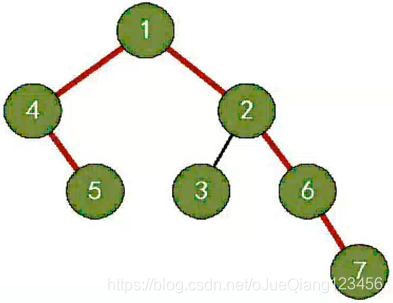
一、概述
- Node (结点类)
- BinaryTree (接口类)
- LinkBinaryTree (链表实现的二叉树类)
- Test (测试类)
二、代码
Node:
public class Node {
/** 内容 **/
private Object data;
/** 左子树 **/
private Node leftChild;
/** 右子树 **/
private Node rightChild;
public Node() {
super();
}
public Node(Object data, Node leftChild, Node rightChild) {
super();
this.data = data;
this.leftChild = leftChild;
this.rightChild = rightChild;
}
public Object getData() {
return data;
}
public void setData(Object data) {
this.data = data;
}
public Node getLeftChild() {
return leftChild;
}
public void setLeftChild(Node leftChild) {
this.leftChild = leftChild;
}
public Node getRightChild() {
return rightChild;
}
public void setRightChild(Node rightChild) {
this.rightChild = rightChild;
}
@Override
public String toString() {
return "Node [data=" + data + ", leftChild=" + leftChild + ", rightChild=" + rightChild + "]";
}
}
BinaryTree:
public interface BinaryTree {
/**
* 是否为空树
* @return
*/
public boolean isEmpty();
/**
* 先序遍历(递归)
*/
public void preOrderTraverse();
/**
* 中序遍历(递归)
*/
public void inOrderTraverse();
/**
* 中序遍历(栈)
*/
public void inOrderStack();
/**
* 后序遍历(递归)
*/
public void postOrderTraverse();
/**
* 按层次遍历
*/
public void levelOrderStark();
/**
* 获取树的高度
* @return
*/
public int getHeight();
/**
* 获取树的元素个数
* @return
*/
public int getSize();
/**
* 查找值
* @param obj
* @return
*/
public Node findKey(Object obj);
}
LinkBinaryTree:
public class LinkBinaryTree implements BinaryTree {
/** 根结点 **/
private Node root;
/**
* 是否为空树
*/
public boolean isEmpty() {
return root == null;
}
/**
* 先序遍历(递归)
*/
public void preOrderTraverse() {
System.out.println("先序遍历(递归) 开始");
this.inPreOrderTraverse(this.root);
System.out.println("\n先序遍历(递归) 结束");
}
public void inPreOrderTraverse(Node node) {
if(null != node) {
// 输出根结点的值
System.out.print(node.getData() + " ");
// 左子树先序遍历
this.inPreOrderTraverse(node.getLeftChild());
// 右子树先序遍历
this.inPreOrderTraverse(node.getRightChild());
}
}
/**
* 中序遍历(递归)
*/
public void inOrderTraverse() {
System.out.println("中序遍历(递归) 开始");
this.inInOrderTraverse(this.root);
System.out.println("\n中序遍历(递归) 结束");
}
public void inInOrderTraverse(Node node) {
if(null != node) {
// 左子树先序遍历
this.inInOrderTraverse(node.getLeftChild());
// 输出根结点的值
System.out.print(node.getData() + " ");
// 右子树先序遍历
this.inInOrderTraverse(node.getRightChild());
}
}
/**
* 中序遍历(栈)
*/
public void inOrderStack() {
System.out.println("中序遍历(栈) 开始");
Deque<Node> deque = new LinkedList<Node>();
Node node = this.root;
while (null != node || !deque.isEmpty()) {
while (null != node) {
deque.push(node);
node = node.getLeftChild();
}
if(!deque.isEmpty()) {
Node popNode = deque.pop();
System.out.print(popNode.getData());
node = popNode.getRightChild();
}
}
System.out.println("\n中序遍历(栈) 结束");
}
/**
* 后序遍历(递归)
*/
public void postOrderTraverse() {
System.out.println("后序遍历(递归) 开始");
this.inPostOrderTraverse(this.root);
System.out.println("\n后序遍历(递归) 结束");
}
public void inPostOrderTraverse(Node node) {
if(null != node) {
// 左子树先序遍历
this.inPostOrderTraverse(node.getLeftChild());
// 右子树先序遍历
this.inPostOrderTraverse(node.getRightChild());
// 输出根结点的值
System.out.print(node.getData() + " ");
}
}
/**
* 按层次遍历
*/
public void levelOrderStark() {
System.out.println("按层次遍历(队列) 开始");
this.inLevelOrderStark(this.root);
System.out.println("\n按层次遍历(队列) 开始");
}
public void inLevelOrderStark(Node node) {
if(null != node) {
Queue<Node> queue = new LinkedList<Node>();
queue.add(node);
while (queue.size() > 0) {
int len = queue.size();
for (int i = 0; i < len; i++) {
Node popNode = queue.poll();
System.out.print(popNode.getData() + " ");
if(null != popNode.getLeftChild()) {
queue.add(popNode.getLeftChild());
}
if(null != popNode.getRightChild()) {
queue.add(popNode.getRightChild());
}
}
}
}
}
/**
* 获取树的高度
*/
public int getHeight() {
return this.inGetHeight(this.root);
}
public int inGetHeight(Node node) {
if(null == node) {
return 0;
} else {
// 左子树高度
int i = inGetHeight(node.getLeftChild());
// 右子树高度
int j = inGetHeight(node.getRightChild());
return i > j ? (i+1) : (j+1);
}
}
public int getSize() {
return this.inGetSize(this.root);
}
public int inGetSize(Node node) {
if(null == node) {
return 0;
} else {
// 左子树元素
int i = inGetSize(node.getLeftChild());
// 右子树元素
int j = inGetSize(node.getRightChild());
return i+j+1;
}
}
/**
* 查找值
*/
public Node findKey(Object obj) {
return inFindKey(this.root, obj);
}
public Node inFindKey(Node node, Object obj) {
if(null == node || null == obj) {
return null;
}
if(node.getData() == obj) {
return node;
}
Node leftNode = this.inFindKey(node.getLeftChild(), obj);
Node rightNode = this.inFindKey(node.getRightChild(), obj);
if(leftNode != null && leftNode.getData() == obj) {
return leftNode;
}
if(rightNode != null && rightNode.getData() == obj) {
return rightNode;
}
return null;
}
public LinkBinaryTree() {
super();
}
public LinkBinaryTree(Node root) {
super();
this.root = root;
}
public Node getRoot() {
return root;
}
public void setRoot(Node root) {
this.root = root;
}
}
Test:
public class Test {
public static void main(String[] args) {
// 左子树
Node node5 = new Node(5, null, null);
Node node4 = new Node(4, null, node5);
// 右子树
Node node7 = new Node(7, null, null);
Node node6 = new Node(6, null, node7);
Node node3 = new Node(3, null, null);
Node node2 = new Node(2, node3, node6);
// 根
Node node1 = new Node(1, node4, node2);
BinaryTree binaryTree = new LinkBinaryTree(node1);
// 树是否为空
System.out.println(binaryTree.isEmpty());
// 先序遍历(递归)
binaryTree.preOrderTraverse();
// 中序遍历(递归)
binaryTree.inOrderTraverse();
// 中序遍历(栈)
binaryTree.inOrderStack();
// 查找某个值
System.out.println("查号某个值:" + binaryTree.findKey(7));
// 按层次遍历(队列)
binaryTree.levelOrderStark();
// 后序遍历(递归)
binaryTree.postOrderTraverse();
// 获取树的高度
System.out.println("树的高度:" + binaryTree.getHeight());
// 获取树的元素个数
System.out.println("树元素的个数:" + binaryTree.getSize());
}
}





 本文详细介绍了二叉树的基本概念,包括结点类、接口类和链表实现的二叉树类。深入探讨了二叉树的先序、中序、后序和层次遍历算法,同时提供了递归和非递归(使用栈)的中序遍历实现,以及获取树高度和元素数量的方法。
本文详细介绍了二叉树的基本概念,包括结点类、接口类和链表实现的二叉树类。深入探讨了二叉树的先序、中序、后序和层次遍历算法,同时提供了递归和非递归(使用栈)的中序遍历实现,以及获取树高度和元素数量的方法。

















 被折叠的 条评论
为什么被折叠?
被折叠的 条评论
为什么被折叠?








